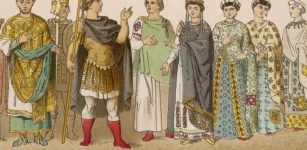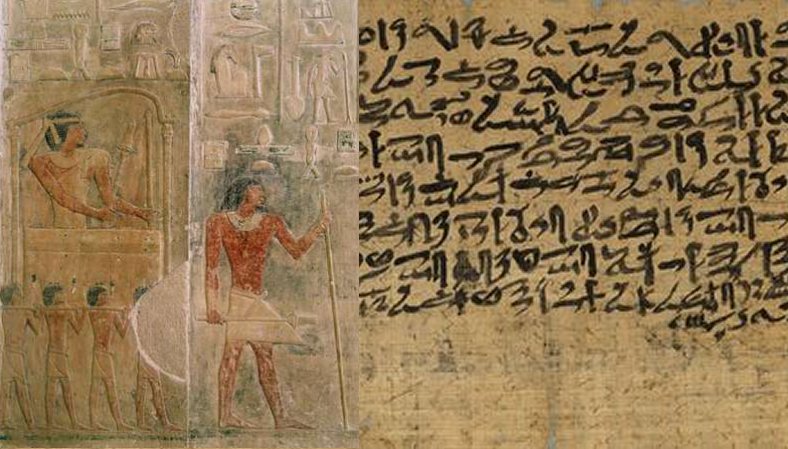Secrets Of Maxims Of Ptahhotep – Ancient Egyptian Wisdom Is Still Relevant Today
Ellen Lloyd - AncientPages.com - The history of ancient Egypt may sometimes seem very distant, but people living thousands of years ago had many problems and feelings that trouble us today.
During the Fifth Dynasty (2,500 B.C. – 2,350 B.C), Egyptian Vizier Ptahhotep, occasionally known as Ptahhotep I, Ptahhotpe or Ptah-Hotep wrote several instructions based on his wisdom and experiences.
His precious text contains advice on how to live your life, and much of what he wrote is still highly relevant today.
The Maxims of Ptahhotep influenced later philosophical works, and his work is one of the first Egyptian books.
Left: Ptahhotep on a palanquin, relief from his tomb. Werner-Forman Archive/Heritage-Images - Right: The Maxims of Ptahhotep, Public Domain
This precious ancient text was discovered in Thebes in 1847 by Egyptologist M. Prisse d’Avennes. There are four copies of the Instructions, and the only complete version, Papyrus Prisse, is located in the Bibliothèque Nationale in Paris.
Vizier Ptahhotep’s wisdom literature was basically a set of moral advice and proverbs for young men. Ptahhotep was a very intelligent man who was the city administrator and vizier (first minister) during the reign of Djedkare Isesi. He had a son named Akhethotep, who was also a vizier. He and his descendants were buried at Saqqara.
His grandson Ptahhotep Tshefi's writings were collected from his grandfather’s texts that were written using hieratic writing, that is, a simplification of the hieroglyphic writing used by the scribes to write on papyri.
In his writings, Ptahhotep reveals that he has dedicated his long life to obtaining wisdom, which can never be completely achieved.
Then the book is spelled out in a series of brief tips that are grouped into 37 topics. In his introduction, reminded us that knowledge is endless. "Do not be arrogant because of your knowledge, but confer with the ignorant man as with the learned. For knowledge has no limits, and none has yet achieved perfection in it."
Originally published as "The Instruction of Ptah-Hotep" and also as "The Maxims of Ptahhotep," the work is believed by some scholars to be the oldest book in the world. Authorship is attributed to Ptahhotep, a vizier under King Isesi of the Egyptian Fifth Dynasty (ca. 2414-2375 BC). It is a collection of maxims and advice in the sebayt ("teaching") genre on human relations and are provided as instruction for his son. The work survives today in papyrus copies, including the Prisse Papyrus which dates from the Middle Kingdom and is on display at the Bibliothèque Nationale in Paris. There are considerable differences between the Prisse Papyrus version and the two texts at the British Museum. The 1906 translation by Battiscombe Gunn, published as part of the "Wisdom of the East" series and which is reprinted here, was made directly from the Prisse Papyrus, in Paris, rather than from copies. Some lessons include: Learning by listening to everybody and knowing that human knowledge is never perfect are a leitmotif. Avoiding open conflict wherever possible should not be considered weakness. Justice should be pursued and in the end it will be a god's command that prevails. Greed is the base of all evil and should be guarded against, while generosity towards family and friends is praiseworthy. Read more
Ptahhotep also advises against listening to rumors and spreading slander. Maxim no. 21 states: "Do not repeat slander; you should not hear it, for it is the result of hot temper."
From Maxim no. 34, we learn that Ptahhotep was a man of peace rather than war. He advised: "Be a craftsman in speech that thou mayest be strong, for the strength of one is the tongue, and speech is mightier than all fighting."
There are naturally many more examples of guidance, and anyone interested in ancient Egyptian wisdom may find his thoughts interesting. His wisdom quotes are collected in The Teachings of Ptahhotep: The Oldest Book in the World.
Ptahhotep rests in the mastaba designated D64. His tomb is famous for its outstanding depictions.
The reliefs in the tomb chamber are the best preserved in the Old Kingdom.
Updated on October 13, 2024
Written by Ellen Lloyd – AncientPages.com
Copyright © AncientPages.com All rights reserved. This material may not be published, broadcast, rewritten or redistributed in whole or part without the express written permission of AncientPages.com
Expand for referencesMore From Ancient Pages
-
 Physical Evidence Of Ancient Atomic Wars Can Be Found World-Wide
Civilizations | Oct 6, 2015
Physical Evidence Of Ancient Atomic Wars Can Be Found World-Wide
Civilizations | Oct 6, 2015 -
 Artificial Intelligence (AI) Unravels Secrets Of 22,000 Ancient Cuneiform Tablets
Artifacts | Feb 2, 2023
Artificial Intelligence (AI) Unravels Secrets Of 22,000 Ancient Cuneiform Tablets
Artifacts | Feb 2, 2023 -
 Mystery Of The Mandala: The Circle Of Life
Ancient Symbols | Jul 7, 2018
Mystery Of The Mandala: The Circle Of Life
Ancient Symbols | Jul 7, 2018 -
 Ancient Greek Seven-Room Building And Treasures Found Underwater Off The Coast Of Salamis
Archaeology | Nov 1, 2023
Ancient Greek Seven-Room Building And Treasures Found Underwater Off The Coast Of Salamis
Archaeology | Nov 1, 2023 -
 Odd Encounter With A Mysterious Cave-Dwelling Creature Who Issued A Warning Described In A Norse Saga
Featured Stories | Feb 27, 2025
Odd Encounter With A Mysterious Cave-Dwelling Creature Who Issued A Warning Described In A Norse Saga
Featured Stories | Feb 27, 2025 -
 Rare Iron Age Crouch Burial Discovered At The Margate Caves Site In Kent, UK
Archaeology | Mar 8, 2018
Rare Iron Age Crouch Burial Discovered At The Margate Caves Site In Kent, UK
Archaeology | Mar 8, 2018 -
 Albert Pike’s Masonic Prophecy About The Three World Wars
Featured Stories | Jan 15, 2018
Albert Pike’s Masonic Prophecy About The Three World Wars
Featured Stories | Jan 15, 2018 -
 Hadrian’s Wall: North-West Frontier Of The Roman Empire For Nearly 300 Years
Featured Stories | Sep 1, 2020
Hadrian’s Wall: North-West Frontier Of The Roman Empire For Nearly 300 Years
Featured Stories | Sep 1, 2020 -
 On This Day In History: First Recorded Passage Of Halley’s Comet Observed By Chinese Astronomers – On Mar 30, 240 BC
News | Mar 30, 2016
On This Day In History: First Recorded Passage Of Halley’s Comet Observed By Chinese Astronomers – On Mar 30, 240 BC
News | Mar 30, 2016 -
 Mystery Of The ‘Mummified Mermaid’ In Japan Solved!
News | Feb 19, 2023
Mystery Of The ‘Mummified Mermaid’ In Japan Solved!
News | Feb 19, 2023 -
 Vali – Son Of Odin, Who Avenged Death Of Balder And Survived Ragnarok
Featured Stories | Aug 29, 2019
Vali – Son Of Odin, Who Avenged Death Of Balder And Survived Ragnarok
Featured Stories | Aug 29, 2019 -
 Cosmic Impact Destroyed Huge Ancient City In The Jordan Valley – Evidence Has Been Found!
Archaeology | Sep 22, 2021
Cosmic Impact Destroyed Huge Ancient City In The Jordan Valley – Evidence Has Been Found!
Archaeology | Sep 22, 2021 -
 Schoolboy Finds A Huge 3,000,000-Year-Old Megalodon Shark Tooth On British Beach
Archaeology | May 9, 2022
Schoolboy Finds A Huge 3,000,000-Year-Old Megalodon Shark Tooth On British Beach
Archaeology | May 9, 2022 -
 On This Day In History: Samurai Final Battle of Shiroyama Was Fought – On Sep 24, 1877
News | Sep 24, 2016
On This Day In History: Samurai Final Battle of Shiroyama Was Fought – On Sep 24, 1877
News | Sep 24, 2016 -
 Draugr – Vikings Feared This Ugly Living Dead With Prophetic Visions
Featured Stories | May 24, 2020
Draugr – Vikings Feared This Ugly Living Dead With Prophetic Visions
Featured Stories | May 24, 2020 -
 Incredible 700-Year-Old Tombs With Beautiful Decorations And Carved Bricks Found In Shandong, China
Archaeology | May 22, 2023
Incredible 700-Year-Old Tombs With Beautiful Decorations And Carved Bricks Found In Shandong, China
Archaeology | May 22, 2023 -
 Justinianic Plague: Modeling Study Challenges Death Rate And Severity Of Infectious Disease
Archaeology | May 4, 2020
Justinianic Plague: Modeling Study Challenges Death Rate And Severity Of Infectious Disease
Archaeology | May 4, 2020 -
 Peopling the Americas: Not “Out of Japan” – Popular Theory Debunked
Archaeology | Oct 13, 2021
Peopling the Americas: Not “Out of Japan” – Popular Theory Debunked
Archaeology | Oct 13, 2021 -
 Evidence Of Ancient Lakes In The Sahara Desert Discovered
Archaeology | Nov 5, 2022
Evidence Of Ancient Lakes In The Sahara Desert Discovered
Archaeology | Nov 5, 2022 -
 Strange Cave Drawings Of Unknown Beings And Animals In Japan Puzzle Historians
Ancient Mysteries | Dec 2, 2019
Strange Cave Drawings Of Unknown Beings And Animals In Japan Puzzle Historians
Ancient Mysteries | Dec 2, 2019


